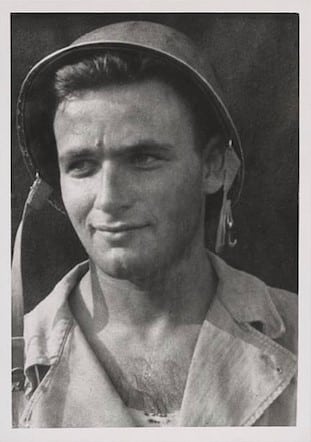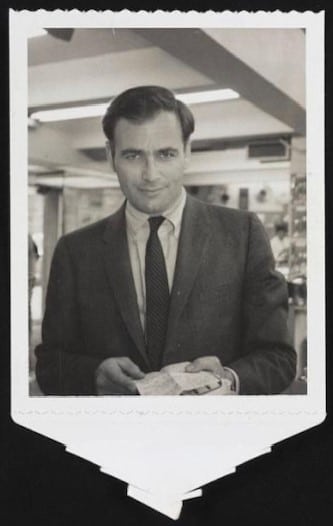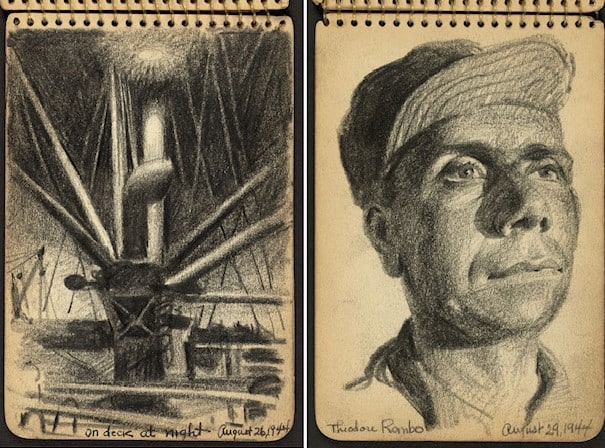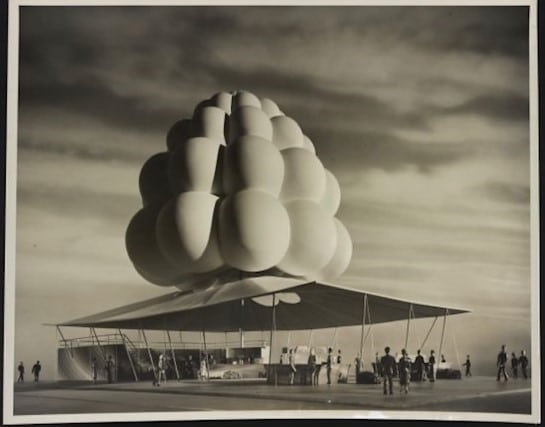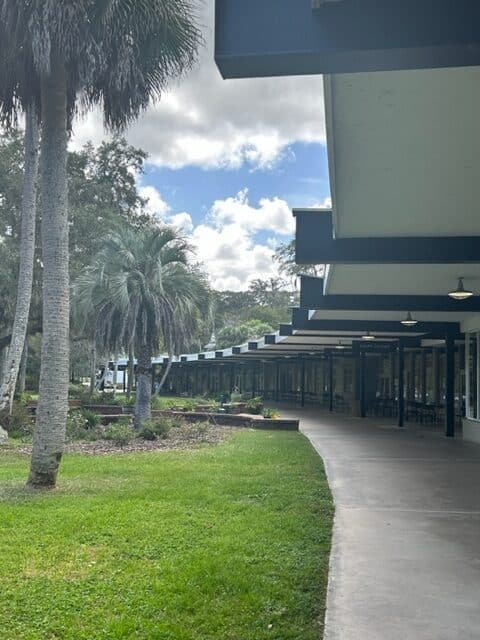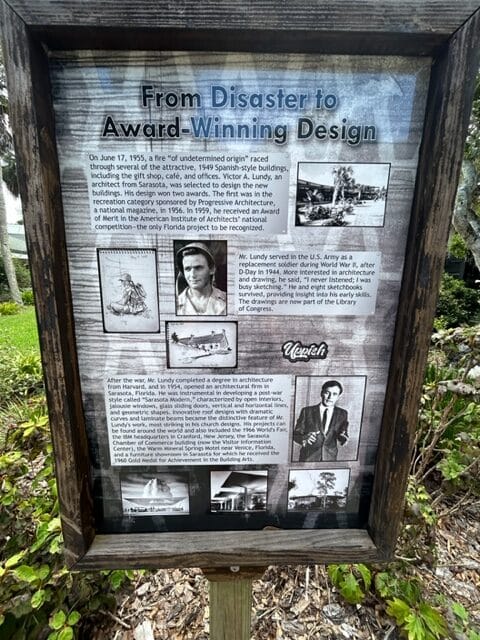We’ve all heard of Frank Lloyd Wright, the famous architect. But how about someone named Victor A. Lundy? That’s an unfamiliar name to me, for sure! And do you know his architectural talent is outstanding and that he has a connection to Florida?
On a recent trip to Silver Springs, a man’s photo stared out at me from an information sign. I was curious. How did he rate a sign? Well, I found out that he was Victor Lundy—a talented sketch artist and an under-appreciated architect. His Victor Lundy Tourist Center (1957) stands the test of time as Florida’s first tourist attraction.
Victor A. Lundy created the area where shops and restaurants are today in Silver Springs almost seventy years ago. He developed his style of “Sarasota Modern” following WWII. He was a resident of Sarasota from 1951 to 1960. He’s known for his open interiors, use of clean vertical and horizontal lines, and eye-catching geometric shapes. His maverick ideas have given us memorable buildings that seem to be “more roof than wall”. He likes to do the unexpected with wood and other materials.
Lundy’s design was chosen above all others to replace the fire-damaged shops of Silver Springs in the mid-1950s. His construction was considered “state of the art” at the time. Today, you can still appreciate the simple lines. You’ll immediately notice the huge I-beams and enormous panes of glass. The walls and sidewalks gently curve, leading the way to those famous glass-bottom boats.
Lundy’s Silver Springs design has won two major awards. It received the 1956 “citation for recreation” from a national magazine called Progressive Architecture. Additionally, it won the 1959 “Award of Merit” in the American Institute of Architects’ national competition. It was the only Florida property to be recognized that year.
Lundy’s War Years
Lundy, the son of Russian immigrants, displayed a real talent for painting and drawing. He studied architecture in his late teens before enlisting in the Army in 1942. He was a young soldier in Patton’s Third Army and earned a Purple Heart. In France, he was one of 16 survivors from a battalion of 360.
In the Army, Lundy always carried with him a pocket-sized sketchbook. It was just a little
3 x 5 spiral-bound notebook that fits in your breast pocket Lundy could draw quickly and used his free time to document what he saw around him. He made portraits of his fellow soldiers and did various drawings of ships, buildings, and landscapes, just to name a few. Only eight of his twenty-seven war sketchbooks have survived. They provide an important visual diary of WWII.
Today, his sketchbooks have been donated to the Library of Congress. The 159 pencil drawings done by Lundy cover the months from May to November 1944 and show his very personal side of the war. One sketchbook cover even bears traces of his blood It’s a grim reminder of combat and the injury that nearly cost Lundy the use of his left arm.
Lundy’s Buildings and Designs
After WWII, Lundy enrolled in the Harvard Graduate School of Design in Cambridge, Massachusetts. It’s considered one of the finest schools of its kind around the globe. In Cambridge, Lundy studied under two masters of modernist architecture, Walter Gropius and Marcel Breuer.
Early in the 1950s, Lundy relocated to Sarasota because of the modernist movement there. He designed various Sarasota churches, stores, meeting houses, and other buildings. Quite a few of them remain today for us to enjoy. Many of them have eye-catching features, such as the blue tile roof of the Sarasota Chamber of Commerce (1956) or the sweeping wooden ceiling inside the Galloway Furniture Store (1959). His Warm Mineral Springs Motel (1958) is noted for its concrete roof canopies of various heights. The motel is listed on the National Register of Historic Places.
During the early 1960s, Lundy moved to New York. There, he was asked to design some temporary snack bars for the 1964–1965 New York World’s Fair. Most architects wouldn’t put much effort into something that would later be dismantled. However, Lundy impressed everyone by putting large fiberglass air sculptures on top of each snack bar. Over twenty snack bars! The sculptures resembled clusters of bubbles or clouds. His “Bubble Pavilions” were easily recognizable from anywhere at the fair. By night in the 1960s, they glowed inside and looked like something otherworldly from outer space.
By the end of the 1960s, Lundy was handpicked to design the United States Tax Court Building in Washington, D.C. Our new 35th president was giving architecture more importance. John F. Kennedy’s 1962 “Guiding Principles for Federal Architecture” stressed that government buildings should display American dignity, stability and vigor, and represent the finest architecture of the time. They should be beautiful, purposeful, and accessible to all.
Lundy made use of the most modern technology for his award-winning United States Tax Court Building (1974). A series of hidden supports hold an impressive 4,000-ton cantilevered courtroom block in place. The massive piece of granite seems to float above the entry. The government building will be preserved for all time. It’s now listed on the National Register of Historic Places under landmarks.
In 1965, Lundy also completed a design for the First Unitarian Church of Westport, Connecticut. (His preliminary sketch is in the Library of Congress.) All who pass the church are drawn to its unique look. The tall, peaked roof resembles a pointed sail set for the wind. Inside, two tall rows of wooden beams rise, but the tops are empty and separated by glass. It’s as if two hands moved apart after being joined in prayer.
In the 1970s, Lundy moved near Houston, Texas. That’s where he resides today. He has done many more buildings—too many to mention. For his 90th birthday back in 2013, the Smithsonian presented him with an award.
Now, ten years later, there is even more fuss and fanfare about Victor A. Lundy. You see, he’s a centenarian, having turned 100 on February 1st! There will be much going on in Sarasota this fall to honor their former resident. This underappreciated architect has certainly caught my attention. I can’t wait for a trip to Sarasota to see what he’s done!
Of Interest:
An exhibit. Infinite Span, Architecture Beyond Sarasota, is open Nov. 2, 2023–Mar. 1, 2024. On display at McCulloch Pavilion, 265 South Orange Ave., Sarasota, FL 34236 Hours: Wednesday–Sunday, 11 a.m.–5 p.m.
MOD Weekend, Sarasota, Nov. 2–5. This year, they are honoring the genius of Victor Lundy. There will be receptions, parties, a film about Lundy’s life, plus walking and driving tours. Full details and tickets are available at:
https://sarasotamod.org

